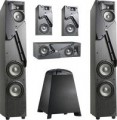Add to comparison |  |  |
|---|---|---|
| JBL Studio 190 Pack 2 5.1 | JBL Studio 190 Pack 1 5.1 | |
from $1,701.00 up to $2,025.00 | from $1,451.85 up to $1,764.00 | |
| TOP sellers | ||
| Features | homemade | homemade |
| Mount | floor/shelf | floor/shelf |
Specs | ||
| Type | passive | passive |
| Number of channels | 5.1 system | 5.1 system |
| Number of speakers | 4 | 4 |
| Number of bands | 3 | 3 |
| Sensitivity | 89 dB | 89 dB |
| Impedance | 8 Ohm | 8 Ohm |
| Crossover frequency | 0.8 / 3.2 kHz | 0.8 / 3.2 kHz |
Power / frequency | ||
| Front | 100 W/channel | 100 W/channel |
| Rear | 90 W/channel | 60 W/channel |
| Centre | 60 W/channel | 60 W/channel |
| Total rated power | 590 W | 530 W |
| Front | 40 – 22000 Hz | 40 – 22000 Hz |
| Rear | 45 – 22000 Hz | 60 – 22000 Hz |
| Centre | 60 – 22000 Hz | 60 – 22000 Hz |
| Overall frequency range | 32 – 22000 Hz | 32 – 22000 Hz |
Subwoofer | ||
| Type | phase inverter | phase inverter |
| Power | 150 W | 150 W |
| Frequency range | 32 – 150 Hz | 32 – 150 Hz |
| Adjustable crossover | ||
| Phase adjustment | ||
| Level adjustment | ||
| LFE input | ||
Design | ||
| Design features | magnetic shielding phase inverter back Bi-Amping/Bi-Wiring | magnetic shielding phase inverter back Bi-Amping/Bi-Wiring |
General | ||
| Tweeter size | 25 mm | 25 mm |
| Midrange speaker size | 100 mm | 100 mm |
| Woofer size (LF/MF) | 165 mm | 165 mm |
| Subwoofer speaker size | 203 mm | 203 mm |
| Finishing material | MDF | MDF |
| Front speaker dimensions (HxWxD) | 112x20x38 cm | 112x20x38 cm |
| Rear speaker dimensions (HxWxD) | 102x20x33 cm | 35х17х21 cm |
| Centre channel dimensions (HxWxD) | 17х53x25 cm | 17х53x25 cm |
| Subwoofer dimensions (HxWxD) | 48х37х37 cm | 48х37х37 cm |
| Weight | 105.4 kg | 80.4 kg |
| Color | ||
| Added to E-Catalog | august 2016 | august 2016 |